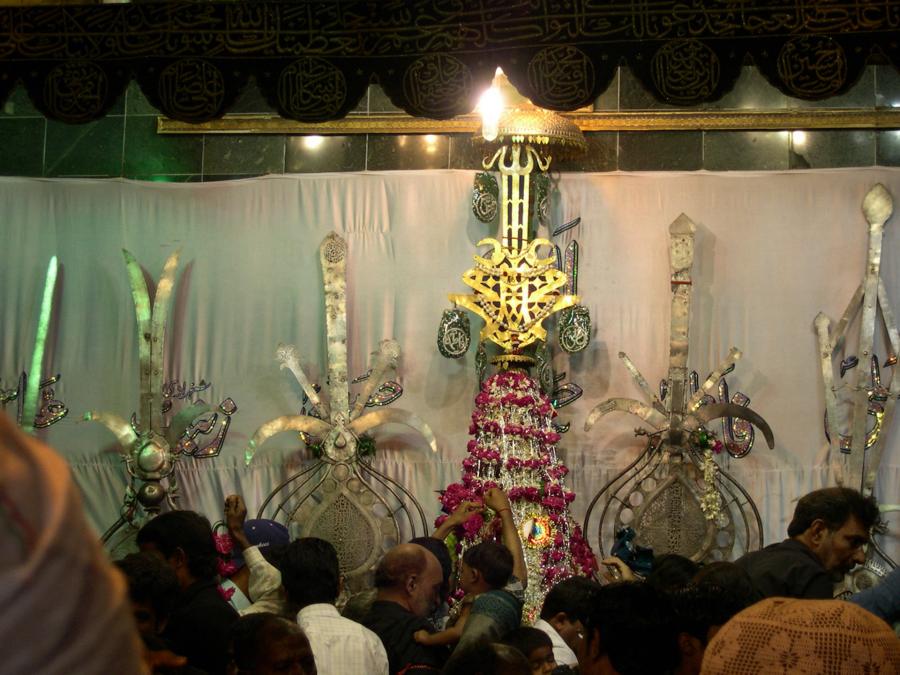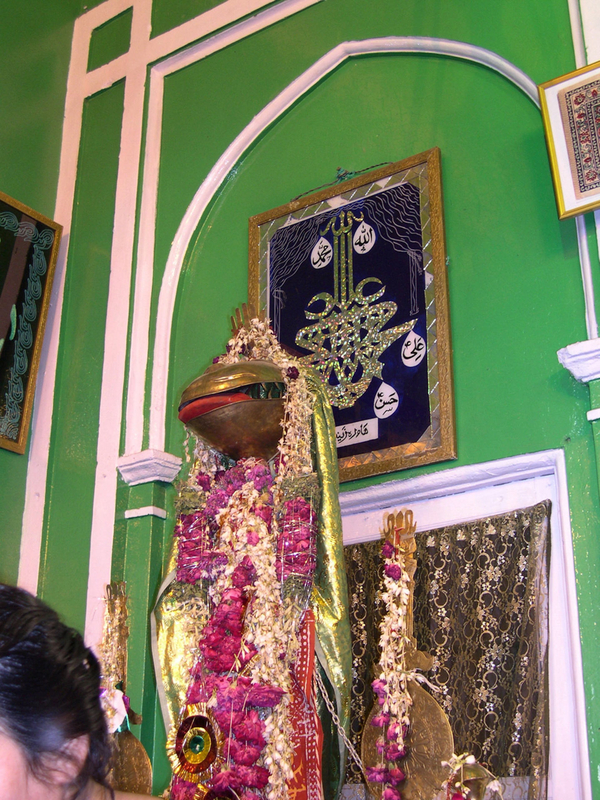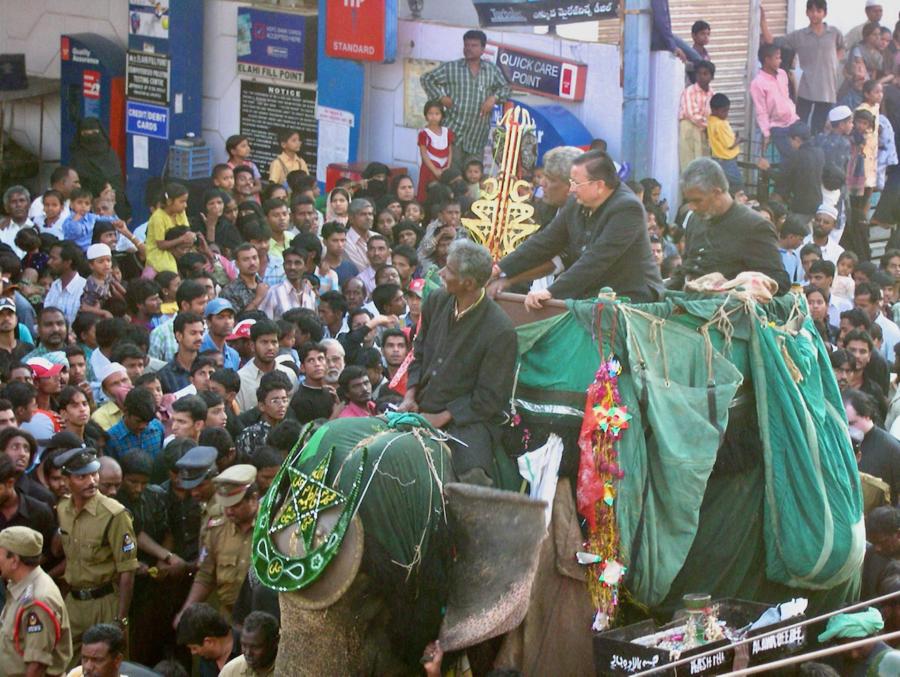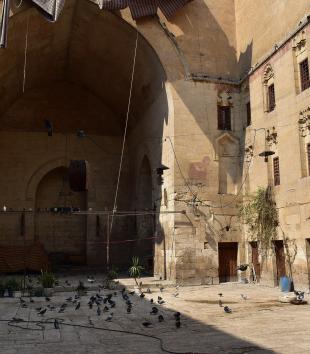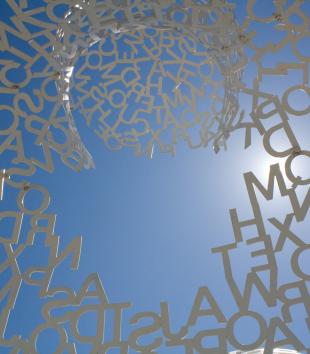Karen Ruffle is Professor in the Departments of Historical Studies and the Study of Religion at the University of Toronto. Her research and teaching interests focus on devotional texts, ritual practice, and Shiʿi material practices in South Asia. Her books include Gender, Sainthood, and Everyday Practice in South Asian Shi’ism (2011) and Everyday Shiʿism in South Asia (2021). Her current projects include a monograph titled, Building the City of Haider: Kingship, Urban Space, and Shiʿi Ritual in Qutb Shahi Hyderabad and a large-scale study of South Asian Shiʿi material culture and sensorial practices titled, Baraka Bodies: Shiʿi Materiality, the Sensorium, and Ritual in India and Pakistan.
The first time I saw the Bībī kā ʿalam was on a warm February afternoon in 2005 (Fig. 1). It was the beginning of Muharram, the first month of the Islamic lunar calendar when the Shiʿa remember and mourn the martyrdom of the third Imam, Husain, who, along with seventy-two of his supporters was killed in the Iraqi desert at a place called Karbala in 680 CE. I joined my colleague, Urdu scholar Amy Bard and two Hyderabadi women, Dr. Zakia Sultana, a geography professor at a local women’s college and prominent majlis orator (zākirah) and Dr. Shemeem, a leader of Yadgar-e Husaini, the women-only ʿāshūrkhānah (a ritual space discussed below), located in Purani Haveli, a Shiʿi neighborhood in Hyderabad’s Old City.1 Riding around in a pair of autorickshaws, we spent an afternoon visiting the many public and private ʿāshūrkhānahs in the Old City, where we paid our respects to these sacred objects.
We stopped in a narrow street outside a building concealed behind plain white walls, typical of much of the traditional architecture in the Old City. Walking through the gate, we entered into a large courtyard, bustling with activity. We had crossed a threshold where the dusty street with its honking horns and crowds of people gave way to a different sort of activity. People come from near and far to seek the intercession of Bibi Fatimah, the daughter of the Prophet Muhammad, wife of Imam ʿAli, and mother of the martyred Imam Husain. Men and women gathered around the alāvā, a large firepit, where for most of the days of Muharram, offerings of incense are made as a votive offering, part of prayers of supplication offered to Fatimah al-Zahra seeking her intercession (see Fig. 2).
- 1The majlis-e ʿazā is a commemorative mourning assembly that takes place during Muharram as well as at other times throughout the year to remember the martyrdom of the Imams and other members of the Ahl-e Bait. The majlis is presided over by a ẕākir (fem. ẕākirah, lit. “one who remembers”), who delivers a thematic discourse called the ẕikr (usually) related to the event being condoled. The discourse is divided into two parts, the first extolling the virtues of the martyr and the Ahl-e Bait, which draws on verses from the Qurʾan, poetry, hadith, and Shiʿi martyrdom narratives (maqtal). The second half of the discourse is called the maṣāʾib (suffering), which brings assembly participants to tears as the ẕākir describes the affliction and death of the martyr in simple, vivid, and deeply intimate language.

Figure 2. Incense offerings at the Bībī kā Alāvā, Hyderabad. Photo by author, 2006.
In Hyderabad, the capital of the southern state of Telangana with a booming population of more than ten million, the city’s Shiʿi population is but a fraction of the total, estimated in 2017 to be approximately 200,000.1 Hyderabad was founded in 1591 by Muhammad Quli (r. 1580–1612), the fifth sultan of the Qutb Shahi dynasty (r. ca. 1496–1687). Since the late-sixteenth century, when Muharram rituals came to be sponsored by the Qutb Shahi state, Muhammad Quli and his successor, the seventh sultan ʿAbdullah (r. 1626–1672) innovated architectural spaces for holding rituals, as well as new material and visual practices that allowed Imam Husain and his family to be absorbed into and appeal to diverse religious constituencies.2
Since the sixteenth century, the ʿalam has been the religious symbol par excellence for the Hyderabadi Shiʿa. In Hyderabad, Shiʿi religious life constellates around the ʿāshūrkhānah (“the house of the tenth”), a ritual space where mourning assemblies are held and ʿalams are raised during Muharram for devotees to venerate and seek their intercession.3 ‘Alams are made in all shapes, sizes, and designs. Some may be only a few inches in height and weigh mere ounces, while others may weigh dozens of pounds and be more than ten feet tall. ʿAlam design varies significantly between the major Shiʿi centers of Hyderabad, Lucknow, Lahore and Karachi, where their material composition, size, and the individuals they represent reflect the particularities of Shiʿi cultural memory. A popular ʿalam design found throughout the subcontinent is in the shape of an outstretched hand, known as a panjah, which variously represents Imam ʿAli or Imam Husain’s half-brother ʿAbbas ibn ʿAli, who is revered for his valiant attempt to collect water in a water-skin (mashk) at the banks of the Euphrates river, where soldiers from the ʿUmayyad caliph’s army severed each of his hands before ultimately decapitating him. Panjahs representing ʿAbbas often have a mashk on a chain suspended from the top of the ʿalam. ʿAlams are more than material representations of the individual that the object signifies; for South Asian Shiʿa the ʿalam is an embodiment of the Imam or member of the Ahl-e Bait (the family of the Prophet Muhammad) that it represents.4 The ʿalam is a materialization of the presence in absence of the Imams and Ahl-e Bait, with whom the Shiʿa can visually interact, to whom they can make supplicatory offerings and vows, and whose intercession can be sought. The ʿalam establishes an immediacy between object and devotee that precludes referring to an ʿalam as “it.” The Bībī kā ʿalam is a materialized embodiment of Fatimah, if only for the ten-day ritual period of Muharram, and she receives and reciprocates the devotional gaze of devotees, both Shiʿa and non-Shiʿa, who seek her intercession in solving problems of health, marriage, family, education, and work.
- 1“Hyderabad’s Shiʿa Community Ready for 10th Muharram Procession” Business Standard, September 30, 2017, https://www.business-standard.com/article/news-ani/hyderabad-s-shia-community-ready-for-10th-muharram-procession-117093000582_1.html.
- 2Karen G. Ruffle, “Presence in Absence: The Formation of Reliquary Shiʿism in Qutb Shahi Hyderabad,” Material Religion 13, no. 3 (2017): 329-353.
- 3The ʿāshūrkhānah is a distinctly Deccani architectural form of Shiʿi religious architecture that is not found outside of South India, although diasporic Shiʿa are establishing domestic ʿāshūrkhānahs in their homes with ʿalams and other objects of devotion they have brought from their natal communities. During Muharram in other parts of India, including Lucknow, Delhi, and Mumbai, and in Karachi, Lahore, and Multan, Pakistan, mourning assemblies are held and ʿalams and taʿziya تعزيه (replica of Imam Husain’s Karbala shrine-tomb) are displayed in other types of religious buildings, notably the imāmbāṛā اٰمامباڑا (the enclosure of the Imam) and imāmbārgāh امامبارگاہ (the court of the Imam). For a discussion of Shiʿi religious architecture and ways space is materially and ritually engaged, see chapter three in my monograph Everyday Shiʿism in South Asia (Hoboken: Wiley, 2021).
- 4I am writing specifically about the meaning and function of the ʿalam in the South Asian Shiʿi context. I do not aim to speak generally for the signifying operation of the ʿalam in the broader Shiʿi world because such material practice and their rituals are co-constituted by normative sources and traditions that are produced by Shiʿas in everyday religious life.
The ʿalam displayed at the Bībī kā Alāvā ʿāshūrkhānah is one of the most beloved by the Hyderabadi Shiʿa. Embedded in the ʿalam is a piece of the wooden plank on which Fatimah’s husband ʿAli gave her body its funerary bath. A Shiʿi pilgrim recovered the relic in Karbala and brought it to Golconda-Hyderabad during the reign of the seventh Qutb Shahi sultan, ʿAbdullah (r. 1626–1672).1 The wooden relic was carved into a wooden ṭughrā (calligram) inscribing the names Allah, Muhammad, and ʿAli, which was then sealed over with a metal alloy of gold and brass.2 The inscriptions placed on ʿalams focus a devotee’s gaze. On the Bībī kā ʿalam, mirrorwork calligraphy, known as musannā, employs the names Allah, Muhammad ,and ʿAli to create an anthropomorphic form. The exact mirroring of these three names on each side of the ʿalam forms a nose, mouth, ears, and two eyes with eyebrows above (see Fig. 1).3 The ʿalam’s ears are studded with two green pouches embroidered with the names ʿAli and Fatimah, which are filled with precious jewels. To the devotee gazing on the ʿalam, these embroidered pouches have the appearance of dangling emerald earrings. In the Shiʿi tradition, emerald (zumurrud) symbolizes the inherited spiritual authority of the Imams.4 These ear pouches are two of the six jewel-filled, embroidered bags that adorn the ʿalam. The Bībī kā ʿalam, as it is popularly known, occupies a special, sacred class of ʿalams for the Hyderabadi Shiʿa. Containing Fatimah’s funerary plank, is a reliquary ʿalam and, while Hyderabad is distinctive for the extraordinary number of relics it possesses that are associated with the Imams and Ahl-e Bait, very few connect to Shiʿi women saints.5 As Hyderabad’s consummate reliquary ʿalam, the Bībī kā ʿalam is accorded top spiritual ranking, symbolized through material practices that convey royal status: adornment with jewels and floral garlands and shading with a parasol. When she was taken out in procession for viewing by devotees and the other ʿalams in the city during the reigns of the Qutb Shahi sultans and the Sunni Asaf Jahi Nizams (r. 1724–1948), the Bībī kā ʿalam was further heralded by the imperial fish ensign, the māhī marātib.6
- 1Karen G. Ruffle, “Presence in Absence,” 340-341.
- 2Sadiq Naqvi, The ʿĀshūr Khānas of Hyderābād City (Hyderabad: Bab-ul-Ilm Society, 2006), 69.
- 3Calligraphy in the shape of a human face finds its consummate expression in the iconography of the Turkish Bektashi Sufi tradition, where Frank de Jong explains the calligraphic mirroring reflects the exoteric (ẓāhir) and esoteric (bāṭin) realities of being. He notes that when ʿAli’s name is written in mirror image, it expresses the Bektashi doctrine: “ ʿAliunAllahu : ʿAli Allahdır : ʿAli is God.” According to de Jong, such iconographic calligraphic images are an aesthetic and decorative “statement of religious identity, and psychological, as a visual representation of the essentials of Bektashi/Alevi belief.” For further discussion, see “The Iconography of Bektashiism: A Survey of Themes and Symbolism in Clerical Costume, Liturgical Objects and Pictorial Art,” Manuscripts of the Middle East 4 (1989): 12. In the South Asian context, Hussein Keshani’s study of inscriptions on the Hussainabad Imāmbāṛā in Lucknow indicates the importance of iconographic calligraphic images in South Asian Shiʿism. Keshani documents calligraphic mirroring to express key Shiʿi doctrinal statements such as the shahāda including the declaration, “ʿAli is the friend of God.” For further analysis and photographs of the Hussainabad Imāmbāṛā, refer to Hussain Keshani, “The Writing on the Walls: Selections from the Twelver Shiʿi Epigraphs of Lucknow’s Hussainabad Imambara,” in People of the Prophet’s House: Artistic and Ritual Expressions of Shiʿi Islam, ed. Fahmida Suleman (London: Azimuth Editions, 2015), 115-125. Writing about Hyderabadi Shiʿism, Diane D’Souza observed the distinctly anthropomorphic qualities of the city’s ʿalams: “For the outsider it is hard to overlook the anthropomorphic character of the ʿalam. Jewels or stylized earrings may be incorporated to link the icon to personalities that are part of an inherited Shia worldview,” in Partners of Zaynab: A Gendered Perspective of Shia Muslim Faith (Columbia: University of South Carolina Press, 2014), 147. Although not directly about the ʿalam, Tryna Lyons’s essay documenting the history of taʿziya construction and their procession rituals in Multan, Pakistan offers fascinating insights into the intrinsically anthropomorphic qualities of these monumental likenesses (shabīh) of Imam Husain’s Karbala shrine-tomb, notably the symbolism of the cupola to the Imam’s head. See Tryna Lyons, “Some Historic Taʿziyas of Multan,” in People of the Prophet’s House: Artistic and Ritual Expressions of Shiʿi Islam, ed. Fahmida Suleman (London: Azimuth Editions, 2015), 221-231.
- 4Karen G. Ruffle, “Gazing in the Eyes of the Martyrs: Four Theories of South Asian Visuality,” Journal of Material Cultures in the Muslim World 1, no. 1 (2020): 277.
- 5For extended discussion of the relics associated with Fatimah in Hyderabad, see Karen G. Ruffle, “May Fatimah Gather Our Tears: The Mystical and Intercessory Powers of Fatimah al-Zahra in Indo-Persian, Shiʿi Devotional Literature and Performance,” Comparative Studies of South Asia, Africa and the Middle East 30, no. 3 (2010): 391-392.
- 6Ruffle, “Presence in Absence,” 338.
Devotees may view the ʿalam, and access Fatimah’s intercessory powers and blessings, both within the ʿāshūrkhānah precincts and in her annual procession. On the afternoon of 10 Muharram, the Bībī kā ʿalam leaves the ʿāshūrkhānah in the Dabirpura neighborhood to undertake a grand, royal procession that makes its way through the Old City atop an elephant, where she can be seen by tens of thousands of devotees. Accompanying theʿalam in procession are associations (anjuman or gurūh) that perform various types of bloody self-flagellation (khūnī mātam) with their hands and implements to which chains and blades are attached (zanjīr zanī). Striking oneself on the chest for extended periods of time until the skin splits open, or lashing the back with chains and blades, drawing copious amounts of blood is an expression of Shiʿi love and loyalty to Fatimah al-Zahra and in recognition of the sacrifice of Fatimah’s son Husain on the Karbala battlefield in 680 CE. The elephant is accompanied by a rank of fourteen steel ʿalams of varying designs that are carried on extra-long poles (nāʾizah) (Fig. 5). The length of these poles serves to convey the status of the ʿalams and allows them to serve as clarions announcing the impending arrival of the exalted Bībī kā ʿalam. In Hyderabad, a nāʾizah’s length connotes an ʿalam’s status—the taller the pole, the more exalted the standard, exemplified by the naʿl-e mubārak ʿalam, containing Hyderabad’s oldest Shiʿi relic, a piece of Imam Husain’s helmet.1 Steel is associated with martial prowess, and the fourteen steel ʿalams that proceed the Bībī kā ʿalam have a dual signifying role. Primarily, they announce and serve as protective sentinels over the Bībī kā ʿalam’s movement through the Old City in her royal cortege. Secondarily, the number fourteen plays on Shiʿi number symbolism, invoking the “Fourteen Infallibles” (chārdah maʿṣūmīmth (e Prophet Muhammad, Fatimah, and the twelve Imams.
- 1This relic was gifted to the fourth sultan, Ibrahim (r. 1550–1580), who had the relic fashioned into a calligraphic ʿalam in the form of the name Allah, which is covered with a thick layer of sandalwood paste. Ruffle, “Presence in Absence,” 339.
The Hyderabadi Shiʿa invoke the presence of the shāhzādī-ye kaunain, the Mistress of the Two Worlds (Fatimah), through a repertoire of rituals and material objects that emphasize her exalted status as the mother of the Imamate, the daughter of the Prophet Muhammad, and the caretaker of the house of sorrows (bait al-aḥzān) who bears witness to the tears shed by those loyal to her family and its cause.1 The Bībī kā ʿalam, the rituals that take place at its ʿāshūrkhānah, and the massive 10 Muharram procession, which has thrived for more than 350 years, reflect the deep traditions of devotion among the Hyderabadi Shiʿa to Fatimah’s intercessory powers as a saint endowed with the grace to intervene in the affairs of this world and the next.
Image-objects such as the Bībī kā ʿalam are experienced at the intersection of what I have theorized elsewhere as the religious sensorium, “a symbolically rich religio-social space where ritual practitioners engage with material objects and the body to produce sense experiences,” which in the Shiʿi context brings collective memory of Karbala into the present.2 Both Shiʿi and Hindu devotees perform rituals of hospitality (making offerings and prayers of supplication) while participating in acts of reciprocal gazing with the Bībī kā ʿalam, whether installed in the ʿāshūrkhānah or taken out in grand procession on 10 Muharram. For Hindus, this ritual act is darśan, for Shiʿa, it is naẓar or dīdār. In both contexts it is an act of auspicious gazing with an object that the practitioner believes contains the embodiment of the god (Hindu context) or Imam (Shiʿi context), to whom greetings, prayers, offerings, and supplications must be made with the correct etiquette and purity of heart. Making supplicatory prayers, vows, and performing the rituals of “visitation” (ziyārat) are deeply personal acts of devotion that take place between a devotee and the Imam or member of the Prophet Muhammad’s family (the Ahl-e Bait), that the ʿalam represents. David Pinault has described Shiʿi acts of religious seeing as darśanic, fundamentally “imagistic in orientation.”3 In his work on immateriality and presence, Victor Buchli has argued that nearness “is achieved through an icon.”4 I agree with Pinault and Buchli’s assessment of the imagistic and proximal power the icon exerts over the devotee as “viewer,” however, this action is never one-sided, and it is enveloped in a web of other ritual acts and desires that activate the gaze and its intercessory response. Vows, supplications, and visitations to the Imams and Ahl-e Bait are intimately bound up in acts of mutual visual exchange before image-objects such as ʿalams and taʿziyas (replica of Imam Husain’s Karbala shrine-tomb) in Shiʿi South Asia. While Muharram is a period of mourning for the suffering and martyrdom of Imam Husain and his family at Karbala, it is also a time much anticipated by the Shiʿa, when gazing on the ʿalams affirms bonds of loyalty and love for members of the Ahl-e Bait, assuring their enduring presence in absence.
- 1For further discussion of the concept of the “house of sorrows,” see Mahmoud Ayoub, Redemptive Suffering in Islam: A Study of the Devotional Aspects of ʿĀshūrā’ in Twelver Shīʿism (The Hague: Mouton, 1978); regarding Fatimah’s intercessory powers, Karen G. Ruffle, “May Fatimah Gather Our Tears,” 386-397.
- 2Karen G. Ruffle, Everyday Shiʿism in South Asia, 166.
- 3David Pinault, Horse of Karbala: Muslim Devotional Life in India (New York: Palgrave, 2001), 18; see also Ruffle, “Gazing in the Eyes of the Martyrs,” 284.
- 4Victor Buchli, “Presencing the Im-Material,” In An Anthropology of Absence: Materializations of Transcendence and Loss, ed. Mikkel Bille, et al. (New York: Springer, 2010), 109.
Notes
Keywords
Imprint
10.22332/mav.obj.2022.4
1. Karen Ruffle, "Bībī kā ʿAlam," Object Narrative, MAVCOR Journal 6, no. 2 (2022), doi: 10.22332/mav.obj.2022.4.
Ruffle, Karen. "Bībī kā ʿAlam." Object Narrative. MAVCOR Journal 6, no. 2 (2022), doi: 10.22332/mav.obj.2022.4.
